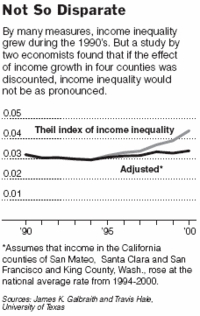 Source of graphic: online version of the NYT article cited below.
Source of graphic: online version of the NYT article cited below.
It is widely recognized that income inequality increased in the 1990’s, but nobody knows quite why. Despite the lack of hard evidence, there are plenty of theories.
. . .
Two University of Texas researchers, James K. Galbraith and Travis Hale, added an interesting twist to this debate in a paper, “Income Distribution and the Information Technology Bubble” (utip.gov.utexas.edu/abstract.html#UTIP27).
According to Mr. Galbraith and Mr. Hale, much of the increase in income inequality in the late 1990’s resulted from large income changes in just a handful of locations around the country — precisely those areas that were heavily involved in the information technology boom.
. . .
A big advantage of looking at county data is that it is possible to identify counties that contributed the most to the increase in income inequality from 1994 to 2000. It turns out that the five biggest winners in this period were New York; King County, Wash. (with both Seattle and Redmond); and Santa Clara, San Mateo and San Francisco, Calif., the counties that make up Silicon Valley. The five biggest losers were Los Angeles; Queens; Honolulu; Broward, Fla.; and Cuyahoga, Ohio.
What do the counties in the first list have in common? Their economies were all heavily driven by information technology in the late 90’s. This is true for the rest of the list of winners as well. Harris, Tex. (home to Houston and Enron); Middlesex, Mass. (home to Harvard and M.I.T.); Fairfield, Conn.; Alameda, Calif.; and Westchester, N.Y., were also among the top 10 income gainers in this period.
The authors point out that half the 80 American companies in the CNET Tech Index are in those top 10 counties. Furthermore, when income inequality decreased after 2000, the income drop in the high-tech counties contributed most to the decline.
For the full commentary, see:

